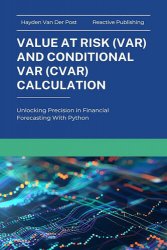 Название: Value at Risk (VaR) and Conditional VaR (CVaR) Calculation: Unlocking Precision in Financial Forecasting With Python
Название: Value at Risk (VaR) and Conditional VaR (CVaR) Calculation: Unlocking Precision in Financial Forecasting With PythonАвтор: Hayden Van Der Post
Издательство: Reactive Publishing
Год: 2024
Страниц: 470
Язык: английский
Формат: pdf, epub, mobi
Размер: 10.1 MB
Unlock the potential of advanced financial risk management with "Value at Risk (VaR) and Conditional VaR (CVaR) Calculation." Matched perfectly for finance professionals, quantitative analysts, and data science enthusiasts, this compendium is your definitive guide to mastering the sophisticated techniques of VaR and CVaR — two pivotal metrics in understanding and mitigating financial risk.
Dive deep into the world of risk management and enhance your toolkit with pragmatic, step-by-step tutorials on implementing VaR and CVaR models. Leverage the power of Python to translate theoretical concepts into practical, real-world applications. If you were intrigued by the foundational concepts in top-selling books but crave more comprehensive, advanced methodologies, this book is your next logical move.
From the mathematical underpinnings to the subtle nuances of model implementation, this book covers:
- In-depth explorations of VaR and CVaR concepts, tailored to both beginners and seasoned professionals.
- Detailed guidance on setting up and utilizing Python environments for risk modeling.
- Step-by-step implementation of a variety of VaR and CVaR models, complete with code snippets and real-world examples.
- Techniques for testing and validating your models, ensuring accurate and reliable risk assessments.
- Insights into the latest advancements in risk management, preparing you for the challenges and opportunities in today’s dynamic financial landscape.
The essence of risk management lies in its ability to safeguard economic stability while fostering growth. Chapter 1 sets the stage by introducing the foundational elements of financial risk management, elucidating the types of financial risks, from market to credit to operational. It navigates through the intricacies of key concepts like risk, uncertainty, and exposure, tracing the historical development of risk metrics and their regulatory significance. This introduction underscores the critical role technology plays in modern risk management and provides an overview of VaR and CVaR, setting the objectives for the ensuing chapters.
Chapters 4 and 5 delve into the crucial role of data in risk management. From data collection, cleaning, and preparation to understanding statistical methods and probability distributions, these chapters equip you with the necessary tools and techniques. High-quality data and sound statistical analysis form the backbone of effective VaR and CVaR calculations, and the methodologies outlined here are pivotal to that end.
Chapters 6 through 8 provide an in-depth exploration of different calculation methods for VaR and CVaR. Historical Simulation, Parametric Method, and Monte Carlo Simulation each have unique benefits and challenges. Detailed implementation steps in Python, supplemented by performance assessments and case studies, bring these methods to life, ensuring you can apply them in real-world scenarios.
Python's popularity in finance stems from its simplicity, readability, and extensive library support, which enable analysts and developers to efficiently manipulate large datasets, perform complex calculations, and visualize data. Unlike some traditional programming languages that may have steeper learning curves, Python is accessible to both novice coders and experienced developers, making it a go-to language for financial professionals.
Python's true strength lies in its rich ecosystem of libraries tailored for data analysis. Key libraries such as NumPy, Pandas, SciPy, and Matplotlib form the backbone of financial data analysis, offering tools for numerical computations, data manipulation, statistical analysis, and data visualization.
Written with clarity and precision, this book makes complex topics accessible without sacrificing depth. Whether you're looking to enhance your risk management strategies or aiming to bridge the gap between theoretical knowledge and practical application, "Value at Risk (VaR) and Conditional VaR (CVaR) Calculation" is your indispensable resource.
Elevate your expertise, sharpen your skills, and lead the charge in sophisticated financial risk management. Get your copy today and embark on a journey of advanced learning and professional growth!
Contents:
Скачать Value at Risk (VaR) and Conditional VaR (CVaR) Calculation: Unlocking Precision in Financial Forecasting With Python
